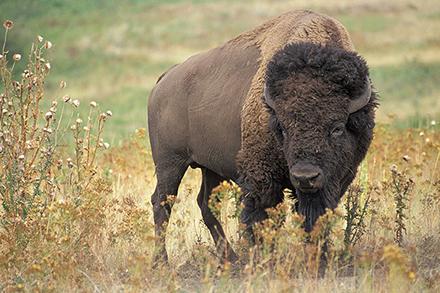Hide and Seek
It’s a killer disease that comes for its victims like a wolf in sheep’s clothing – oftentimes, literally.
Malignant catarrhal fever (MCF) is a deadly viral disease that strikes bison, various deer species, cattle, and pigs. Sheep and some other animals are carriers of MCF without showing any symptoms themselves, which makes it difficult for ranchers to protect their herds.
There is no cure and no treatment for MCF. All that veterinarians can do is try to relieve symptoms. Those symptoms can include fever, discharge from eyes and nose, and not eating or drinking. Sometimes no symptoms at all are seen, yet an animal is found dead.
“The only way to prevent the spread of MCF [is the] separation of susceptible and carrier species,” said Cristina Cunha, veterinary medical officer with the Agricultural Research Service’s (ARS) Animal Disease Research (ADRU) unit in Pullman, WA. “Unfortunately, effective separation of animals is impractical in some agricultural settings.”
Cunha, along with her colleague and fellow veterinary medical officer with ARS/ADRU Naomi Taus, leads a research project aimed at generating tools to help control MCF.
The MCF virus carried by sheep is called ovine gammaherpesvirus 2 (OvHV-2). Its fatality rate is high; in one case, a bison feedlot in Idaho experienced an outbreak and lost 825 out of 1,610 animals – 51% of the herd. Death rates of close to 100% have also been reported on small bison ranches.
Bison have several roles in American society. Besides being livestock, they are also wildlife, a religious symbol for Native Americans, and a cultural symbol as the National Mammal of the United States. Following near extinction in the late 1800s, today’s bison population in North America is approximately 400,000 animals.
Currently, test kits to determine if sheep are positive for OvHV-2 are available only in lab settings.
“This is why one of our project objectives is to develop a point-of-care test that is easy, inexpensive, and practical for the identification of positive carriers and possible threats,” Cunha said. “Such a test will be extremely valuable for multiple-species livestock operations, zoos, and game farms where MCF virus carriers and susceptible species are housed close together.”
MCF occurs worldwide and is a problem anywhere carrier species are in contact with susceptible species. Brazil is of particular interest to the researchers due to the combination of ranchers who co-graze their sheep and cattle and the nation’s high diversity of animal species that can serve as MCF virus carriers.
“We are interested in looking into some of these species with the goal of better understanding the risk for disease-susceptible animals,” Cunha explained.
Cunha’s team of researchers are racing to develop a vaccine to mitigate MCF, but it’s a complex task that involves several steps, from discovery to manufacturing and commercialization. To date, the team has identified the OvHV-2 proteins that are essential for virus infection, and is testing a promising vaccine candidate for safety and efficacy in natural hosts (cattle and bison).
“The availability of a vaccine and easy access to diagnostic tests [would] be highly beneficial for some livestock industries and multi-species operations,” Cunha said. “[They could] help animal management by allowing susceptible species to be close to carriers without the risk of a fatal disease.”
Though Cunha’s research team is small and has limited funding, she’s confident that a vaccine and tests for MCF are just down the road. However, the timing is hard to pinpoint.
“It will take [some] years until producers can have something to use, especially for a vaccine; there are too many steps to go through to get a new vaccine on the market quickly,” Cunha said. “Importantly, as a small research group working with a virus that cannot be cultured in the laboratory, we are [making] incredible progress.”
For producers, it can’t come soon enough – half of captive bison producers rate MCF as the most important disease, with a potential to significantly impact animal agriculture in the United States. – by Scott Elliott, ARS Office of Communications
Also in our series on exotic animal diseases:


